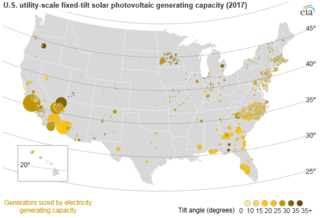Southern Company is an American gas and electric utility holding company based in the southern United States. It is headquartered in Atlanta, Georgia, with executive offices also located in Birmingham, Alabama. The company is currently the second largest utility company in the U.S. in terms of customer base. Through its subsidiaries it serves 9 million gas and electric utility customers in 6 states. Southern Company's regulated regional electric utilities serve a 120,000-square-mile (310,000 km2) territory with 27,000 miles (43,000 km) of distribution lines.

The electric power industry covers the generation, transmission, distribution and sale of electric power to the general public and industry. The commercial distribution of electric power started in 1882 when electricity was produced for electric lighting. In the 1880s and 1890s, growing economic and safety concerns lead to the regulation of the industry. What was once an expensive novelty limited to the most densely populated areas, reliable and economical electric power has become an essential aspect for normal operation of all elements of developed economies.

Vermont Yankee was an electricity generating nuclear power plant, located in the town of Vernon, Vermont, in the northeastern United States. It generated 620 megawatts (MWe) of electricity at full power. The plant was a boiling water reactor (BWR), designed by General Electric. It operated from 1972 until December 29, 2014, when its owner Entergy shut down the plant. In 2008, the plant provided 71.8% of all electricity generated within Vermont, amounting to 35% of Vermont's electricity consumption. The plant is on the Connecticut River, upstream of the Vernon, Vermont Hydroelectric Dam and used the reservoir pool for its cooling water.
Puget Sound Energy (PSE) is an energy utility based in the U.S. state of Washington, providing the Puget Sound region with electrical power and natural gas. The utility serves electricity to more than 1.1 million customers in Island, King, Kitsap, Kittitas, Pierce, Skagit, Thurston, and Whatcom counties, and provides natural gas to 750,000 customers in King, Kittitas, Lewis, Pierce, Snohomish and Thurston counties. The company's electric and natural gas service area spans 6,000 square miles (16,000 km2).

The electricity sector in Canada has played a significant role in the economic and political life of the country since the late 19th century. The sector is organized along provincial and territorial lines. In a majority of provinces, large government-owned integrated public utilities play a leading role in the generation, transmission, and distribution of electricity. Ontario and Alberta have created electricity markets in the last decade in order to increase investment and competition in this sector of the economy.
Saskatchewan Power Corporation, operating as SaskPower, is the principal electric utility in Saskatchewan, Canada. Established in 1929 by the provincial government, it serves more than 538,000 customers and manages over $11.8 billion in assets. SaskPower is a major employer in the province with over 3,100 permanent full-time staff located in approximately 70 communities.
Nova Scotia Power Inc. is a vertically integrated electric utility in Nova Scotia, Canada. It is privately owned by Emera and regulated by the provincial government via the Nova Scotia Utility and Review Board (NSUARB). Nova Scotia Power Inc provides electricity to 520,000 residential, commercial and industrial customers in Nova Scotia.

Making up over 57% of the state's generated electricity in 2020, wind power is the largest source of electricity generation in Iowa. In 2020, over 34 billion kWh of electrical energy was generated by wind power. As of Q3 2020, Iowa has over 10,951 megawatts (MW) of installed capacity with 5,590 wind turbines, ranking 2nd and 3rd in the nation below Texas respectively.

Solar power in the United States includes utility-scale solar power plants as well as local distributed generation, mostly from rooftop photovoltaics. As of the end of 2020, the United States had 97,275 megawatts (MW) of installed photovoltaic and concentrated solar power capacity combined. In 2018, utility scale solar power generated 66.6 terawatt-hours (TWh), 1.66% of total U.S. electricity. During the same time period total solar generation, including estimated small scale photovoltaic generation, was 96.1 TWh, 2.30% of total U.S. electricity. In terms of total cumulative installed capacity, by year end 2017 the United States ranked 2nd in the world behind China. In 2016, 39% of all new electricity generation capacity in the country came from solar, more than any other source and ahead of natural gas (29%). By 2015, solar employment had overtaken oil and gas as well as coal employment in the United States. In 2016, more than 260,000 Americans were employed in the solar industry.

The energy sector in Hawaii has rapidly adopted solar power due to the high costs of electricity, and good solar resources, and has one of the highest per capita rates of solar power in the United States. Hawaii's imported energy costs, mostly for imported petroleum and coal, are three to four times higher than the mainland, so Hawaii has motivation to become one of the highest users of solar energy. Hawaii was the first state in the United States to reach grid parity for photovoltaics. Its tropical location provides abundant ambient energy.
Vermont electric power needs are served by over twenty utilities. The largest is Green Mountain Power, a subsidiary of Énergir which recently also took over Central Vermont Public Service. Together this single company represents 70% of the retail customers in Vermont. The state is a small electricity consumer compared with other states. Therefore, its electricity sector has the lowest carbon footprint in the country. As of 2010, the state had the lowest wholesale electricity costs in New England. Efficiency Vermont engages in aggressive initiatives to cut residential electricity waste, which often identifies other problems that it claims can save hundreds per household per year. Accordingly, Vermont's overall energy bills are also relatively lower than in the rest of the New England states.

The Moran Municipal Generation Station is a former 30-megawatt power plant known for its architecture and innovation built in Burlington, Vermont from 1952 to 1955. It is now a derelict structure that will be redeveloped to encourage year-round use, economic activity and public access. The Moran Plant is located at 475 Lake Street on the Burlington waterfront. It is named for Burlington mayor J.E. Moran.

Solar power in Vermont provides almost 11% of the state's electricity as of 2018. A 2009 study indicated that distributed solar on rooftops can provide 18% of all electricity used in Vermont. A 2012 estimate suggests that a typical 5 kW system costing $25,000 before credits and utility savings will pay for itself in 10 years, and generate a profit of $34,956 over the rest of its 25-year life.

Energy in California is a major area of the economy of California. California is the state with the largest population and the largest economy in the United States. However, it is second in energy consumption after Texas. As of 2018, per capita consumption was the fourth-lowest in the United States partially because of the mild climate and energy efficiency programs.
The U.S. state of Arkansas is a significant producer of natural gas and a minor producer of petroleum.

The electricity sector in the Philippines provides electricity through power generation, transmission, and distribution to many parts of the Philippines. The Philippines is divided into three electrical grids, one each for Luzon, the Visayas and Mindanao. As of June 2016, the total installed capacity in the Philippines was 20,055 megawatts (MW), of which 14,348 MW was on the Luzon grid. As of June, 2016, the all-time peak demand on Luzon was 9,726 MW at 2:00 P.M. on May 2, 2016; on Visayas was 1,878 MW at 2:00 P.M. on May 11, 2016; and on Mindanao was 1,593 MW at 1:35 P.M. on June 8, 2016. However, about 12% of Filipinos have no access to electricity. The Philippines is also one of the countries in the world that has a fully functioning electricity market since 2006 called the Philippine Wholesale Electricity Spot Market(WESM) and is operated by an independent market operator.
Net metering in New Mexico is a set of state public policies that govern the relationship between solar customers and electric utility companies.
Electric grid security in the US refer to the activities that utilities, regulators, and other stakeholders play in securing the national electricity grid. The American electrical grid is going through one of the largest changes in its history, which is the move to smart grid technology. The smart grid allows energy customers and energy providers to more efficiently manage and generate electricity. Similar to other new technologies, the smart grid also introduces new concerns about security.










